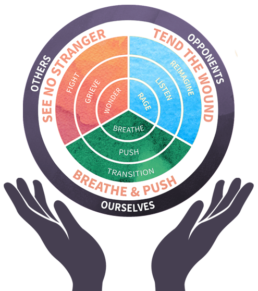6: Reimagine

“In my early life as an activist, marching in the streets, bullhorn to lips, I used the language of resistance….But the longer I spent listening to the stories of marginalized people, tending to their wounds, the more I heard a deeper longing—for a future where we were all safe and secure in our bodies, free to pursue our dreams, where our social, political, and economic institutions supported not just our survival but our flourishing. We could resist with all our might and never deliver such a future. We needed to do more than resist. We needed to reimagine the world.”
“Any social harm can be traced to institutions that produce it, authorize it, or otherwise profit from it. To undo the injustice, we have to imagine new institutions—and step in to lead them.”
– Valarie Kaur, See No Stranger, Chapter 6
Understanding Reimagine
A Practice of Love for Opponents
To reimagine is to explore a vision of a relationship, community, and world where we all flourish. Reimagining means that we’re doing more than resisting our opponents. We are looking at the cultures that radicalize them and institutions that authorize them. This is the moment to declare what is obsolete, what can be reformed, and what must be reimagined. Reimagining focuses us not just on what we are fighting against, but the future that we are fighting for.
- Can you think of a time when you felt like you were in beloved community? When you felt at home in your body and at home in the world? And others were at home in their bodies and at home in the world?
- Explore that memory for a moment. What do you see and hear? Where are you? Are you inside or outside? Are you with a lot of people or are you with a small group of people? Is there singing, music, laughter, talk, food? What are you all doing together? And if it’s hard to find a moment, choose just a sliver of time when it felt good and right. Notice what it feels like in your body.
- What made it feel like a beloved community? What are the elements that made it possible for you and others to feel at home? What container were you in? What was the institution that held you? A home, a house of worship, a group, an organization? And what was it about that container that made it possible for everyone to feel that way?
- What is your vision of the world as it ought-to-be? Imagine that sense of beloved community growing and spreading to all the institutions across society and around the world. Let the images come to you.
- Now think of an institution that has caused harm in your life or community. Perhaps an institution that was responsible for what you were grieving or what you were fighting against. Perhaps you were listening to an opponent who was part of that institution. Think of that powerful structure, whether it’s a school or prison or legislative body or the church down the street. Notice what’s happening in your body and how it makes you feel. And if there’s constriction or discomfort, that’s OK. This is information.
- Can you imagine a version of this institution in which you are well? And that all the people around you are well? What needs to be changed about it? What new policies, what new norms, what new ways of being? And if you cannot imagine a version of this institution in which you could ever feel well, then imagine this institution being labeled obsolete and dismantled. What would you replace it with? What would be better? How would you cultivate beloved community in its place? Imagine that now.
- What is the role of imagination in loving opponents and fighting against injustice?
- How would you reimagine the world you want to live in? What does a collective reimagining of our world require of us?
- What does a world, or a nation, rooted in revolutionary love look like?
- How can these visions of the world inform our actions and commitments in present time?
- Explore your role in institutional change. Choose an institution in your life that needs to be reimagined. It could be a school, a house of worship, an industry, a system, or your own home. What is your role in that labor? What might it look like to start a pocket of revolutionary love where you are? Who can be an accomplice with you. What is the first step?
- Protect spaces to imagine: Find people around you to create a pocket of revolutionary love. Gather together in spaces where you intentionally reimagine the world you are fighting for. This may mean creating art or ceremonies, designing rituals, or journal writing. Remember your values and the world you are fighting for, not only what you are fighting against. Let these visions guide your actions.
- Imagine the world you want to see. Be as specific as possible. What does this world look like, and feel like? What do systems of care, governance, justice, education, and healing look like? Follow the lead of women of color like Alicia Garza and the work of Black Futures Lab, to guide this visioning.
- Work backwards from your vision of the world as it ought-to-be. Who is already doing the work and how can we work with or alongside them? How will we care for each other while we labor, so that we all will last?
- Learn from groups who have been reimagining systems for generations, particularly those led by women of color. These include abolition movements, Indigenous movements for climate change, models of transformative justice, and disability justice. Read the works of visionaries and activists who model the power of radical imagination and action, such as Grace Lee Boggs, Angela Davis, bell hooks, adrienne maree brown, and others.
- Explore histories of movements that place love at the center of their fight for justice. Know that the stories we tell about our histories are the ones that determine our lives and our futures. Commit to amplifying these stories and following their lead.
- Reflect in your wisdom journal: What am I learning about what beloved community means to me? What is my vision of the world as it ought-to-be? What are the stories I tell myself that keep me from expanding my imagination? Who can help me put my visions into action, right here, where I am? Whose visions am I poised to support?

